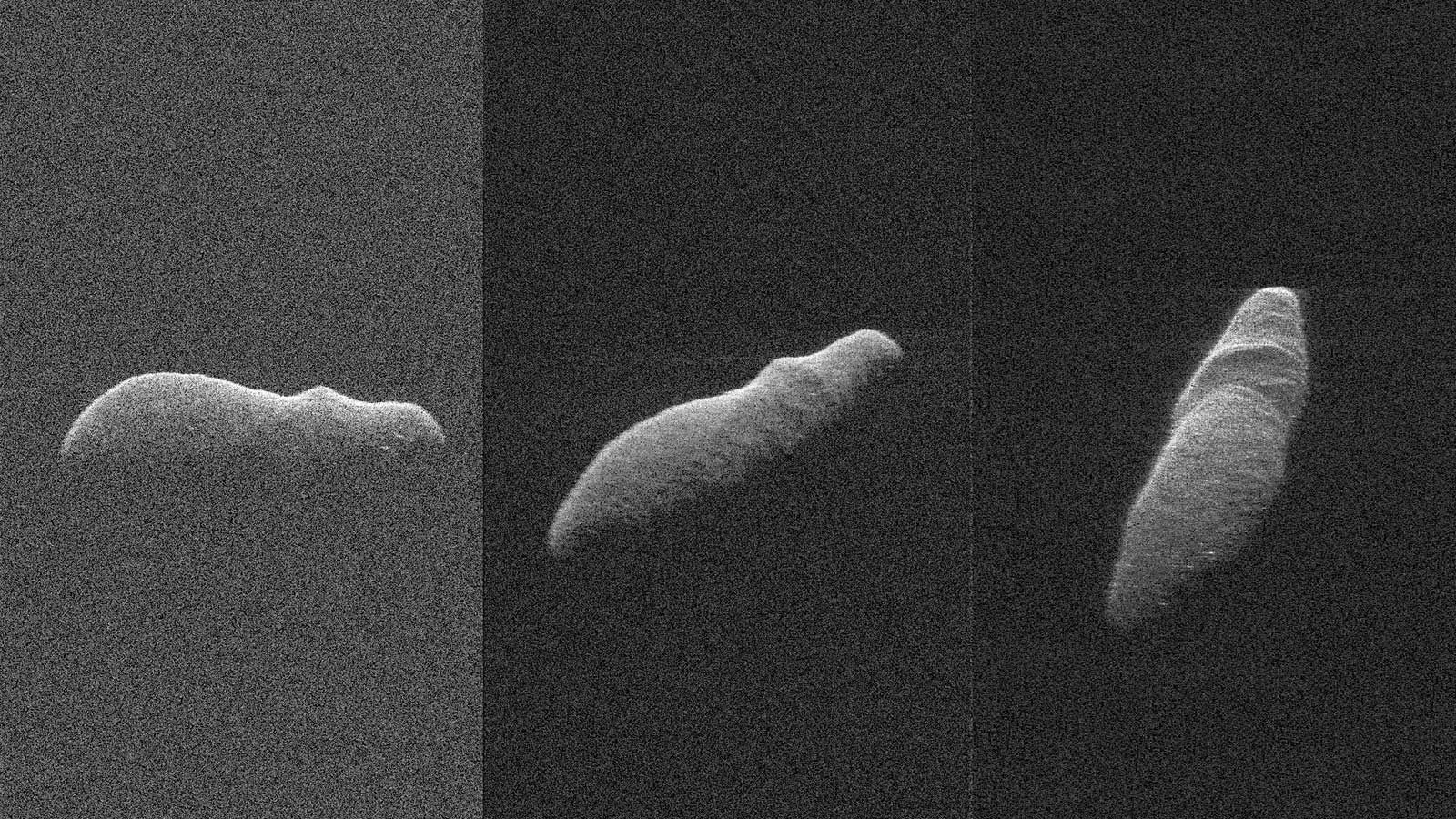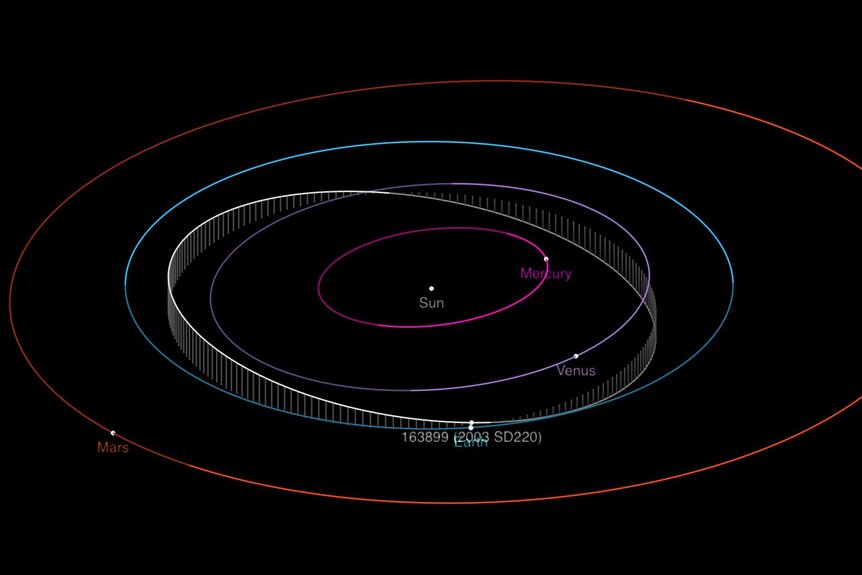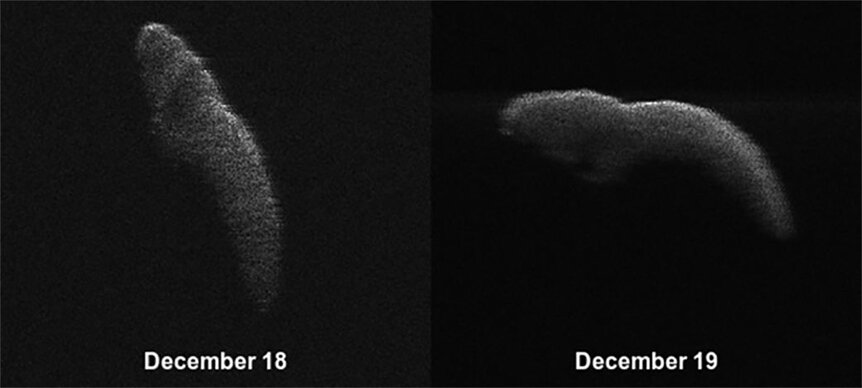Create a free profile to get unlimited access to exclusive videos, sweepstakes, and more!
Jingle bell (space) rock

Last week the Earth was visited by an asteroid, and astronomers caught it on radar. Good thing it wasn't speeding.
The rock is called 2003 SD220, and it's what's called an Aten: an asteroid with an elliptical orbit that generally keeps it closer to the Sun than Earth, but elongated enough that it crosses Earth's orbit. For this reason it's also a Potentially Hazardous Asteroid, one that is big enough and gets close enough to us that some time in the future there's a risk of an impact.
Happily, SD220 will be keeping its distance for some time. It was closest to us on December 22, when it passed us about 2.8 million kilometers away. It won't be this close again until late December 2070 — I guess it likes to be near Earth for the holiday season — and looking over its predicted orbit I'd say we're good for at least a century. So breathe easy.
But it did get close enough to get a decent look at it, at least with radar. Using the big Goldstone 70-meter antenna in conjunction with the ginormous 100-meter Green Bank Telescope and the colossal 305-meter Arecibo telescope in Puerto Rico, astronomers pinged the rock from December 15–19, when it was still over 4 million kilometers away, and what they saw was just really cool:
SD220 is an elongated asteroid, something like 1.6 kilometers long. Near one end is a ridge that goes around it like a collar, and that's adjacent to a valley that's a bit like a neck.
Interesting! In many small bodies like asteroids and comets, we see a variation on a bowling pin shape, elongated with one end wider than the other. In extreme cases these can look like a rubber ducky (like with the comet 67P/Churyumov-Gerasimenko), dog-bone shapes (like Kleopatra), or even two similar-sized bodies orbiting one another. It's likely that these shapes are all related physically. One idea is that two small bodies colliding slowly can merge to form a single elongated one. Another idea is that a single one can get spun up by weak forces enough over time to stretch and snap it in two, and then the two bodies subsequently re-merge, coalescing back into a single body.
Did that happen here with SD220? It's hard to say, but the shape is peculiar enough to make me wonder.
It's important to note that these images aren't really snapshots like you usually see with telescopes. My friend Emily Lakdawalla at The Planetary Society has a great article about how these images are taken (and I've also written about it many times in the past), but in a nutshell the telescope emits pulses of radio waves aimed at the asteroid. These are reflected back to Earth, and the time delay between pulses can be used to map the shape of the asteroid. If a pulse hits a hill on the asteroid, for example, it has to travel less distance than a pulse that falls into a valley. The hill pulse gets back to us a tiny fraction of a second sooner, and that is used to get the asteroid's shape.
More than that, the pulses can get smeared out in wavelength if the asteroid is rotating, because this creates a Doppler shift in the pulses (Emily's article explains all this). If the asteroid rotates rapidly, as many small ones do, the image gets distorted, elongated in the horizontal direction because of this. However, SD220 is actually an excruciatingly slow rotator, spinning roughly once every 12 days, so the distortion is extremely small. The shape we see in these images is pretty much the shape of the asteroid.
Another weirdness of this method is the way the images are displayed. In the usual kind of image you see, it's like you are the telescope looking at the target, seeing the side of it facing Earth. But these radar images are different; the telescope is actually illuminating the asteroid and seeing the radio waves reflected off of it. The way the images are displayed, the direction to Earth is up, like it's above the frame of the image. That's why you see a bright rim along the top of the asteroid — that's where the radio pulses are most strongly reflected back to Earth — and why the asteroid just sorta fades out toward the bottom. It takes some getting used to.
You can also see bright spots on the asteroid, which are probably boulders sitting on the surface, reflecting the radar efficiently. Some darker regions are likely impact craters, too.
Looking at the overall shape I had to chuckle. A lot of asteroids look like potatoes, and I've heard more than one astronomer refer to them as "space spuds." But I smiled even more when I realized the image taken on December 19 looks a lot like a chameleon.
But my biggest smile was for the very first image. It looks just like a hippopotamus wading in a river! Even the next two look like it's slowly turning away from us, going off to do whatever hippopotamuses do.
Maybe it's heading off to do some last-minute shopping? I mean, given the time of year and all.
Speaking of which, I have errands to run as well. So I'll leave you with these images, and simply say…
Hippo Holidays.





























